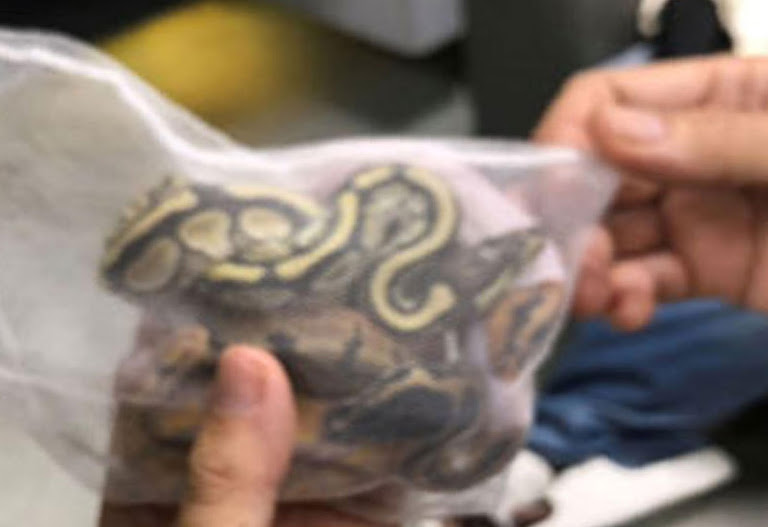Thailand Airport Bust Exposes Dark Web of Exotic Animal Smuggling
Beyond the Underwear: How Online Desire, Corruption, and Lax Laws Fuel Exotic Animal Extinction.

Three ball pythons, nestled where they absolutely shouldn’t be. The detail is undeniably lurid, a pitch-black punchline in the sprawling tragedy of the global wildlife trade. We might chuckle nervously, but to focus on Sheehan, the Sri Lankan man caught at Suvarnabhumi airport, is to miss the forest for a remarkably uncomfortable tree. The real story isn’t about individual actors, but about the interlocking systems of desire, exploitation, and regulatory failure that render stuffing reptiles into one’s underpants a viable, if profoundly disturbing, business model. This isn’t a crime story; it’s a systems analysis.
The Bangkok Post reports that Sheehan’s attempt to smuggle the pythons out of Thailand wasn’t a rookie mistake; he’s apparently a repeat offender. According to Polavee Buchakiat, director of the Wildlife Crime Intelligence Centre, Sheehan had “a record of trafficking various wildlife species, including wolves, meerkats, black cockatoos, sugar gliders, porcupines, ball pythons, iguanas, frogs, salamanders, and turtles.” This isn’t an anomaly. It’s a feature.
Authorities informed the Sri Lankan man that he had violated Section 23 of the Wildlife Conservation and Protection Act for attempting to export controlled wildlife without authorisation and Sections 242, 166 and 252 of the Customs Act for attempting to export goods not cleared through customs.
Sheehan is merely a single, easily replaceable node in a global network sustained by a potent cocktail of factors: the demand for exotic pets, often driven by social media trends and fleeting status symbols; the enduring belief in traditional medicine using animal parts, particularly in some Asian cultures; and the pervasive corruption that greases the wheels of illicit trade. The penalties, clearly, are not a sufficient deterrent when weighed against the potential payoff. So, how do we fundamentally alter that equation?
We need to zoom out, way out. The global wildlife trade, estimated by some to be worth upwards of $20 billion annually, isn’t just an economic activity; it’s a sophisticated, highly adaptive black market ecosystem. It decimates animal populations, fuels political instability through corruption, and dramatically increases the risk of zoonotic disease transmission — as we’ve learned all too painfully in recent years. Ball pythons, relatively harmless and often bred in captivity, might seem insignificant compared to the slaughter of elephants for ivory or the industrial-scale trafficking of pangolins. But every animal ripped from its habitat, every act of smuggling, weakens the delicate threads of biodiversity and accelerates ecological breakdown.
Consider the historical context: The Victorian era, with its mania for collecting exotic specimens for natural history museums and private menageries, laid the groundwork for this system. It normalized the idea of wildlife as a commodity to be possessed, fueling the demand that persists today. As the anthropologist Mary Douglas argued, our categories of “clean” and “dirty” are often social constructs, reflecting deeper cultural anxieties. Perhaps our willingness to commodify and consume wildlife reflects a similar unease about our place in the natural world. This is exacerbated by the anonymous ease of access facilitated by online marketplaces, where a rare bird or reptile is just a click away.
Enforcement, while absolutely necessary, is a perpetual game of whack-a-mole. For every Sheehan apprehended, another will inevitably emerge, enticed by the lure of quick profit. A more sustainable strategy involves strengthening protections for vulnerable populations and ecosystems in at-risk nations, addressing the underlying economic vulnerabilities that drive wildlife crime. This means not only investing in on-the-ground conservation efforts and anti-poaching patrols, but also supporting alternative livelihoods for communities that depend on exploiting these resources.
Ultimately, this demands a profound shift in our cultural values. It’s about recognizing that a ball python is infinitely more valuable thriving in its natural habitat than confined within someone’s underwear. It’s a story not merely about policing borders and enforcing laws, but about transforming our understanding of value — and doing so with a speed and urgency that matches the accelerating pace of extinction.









